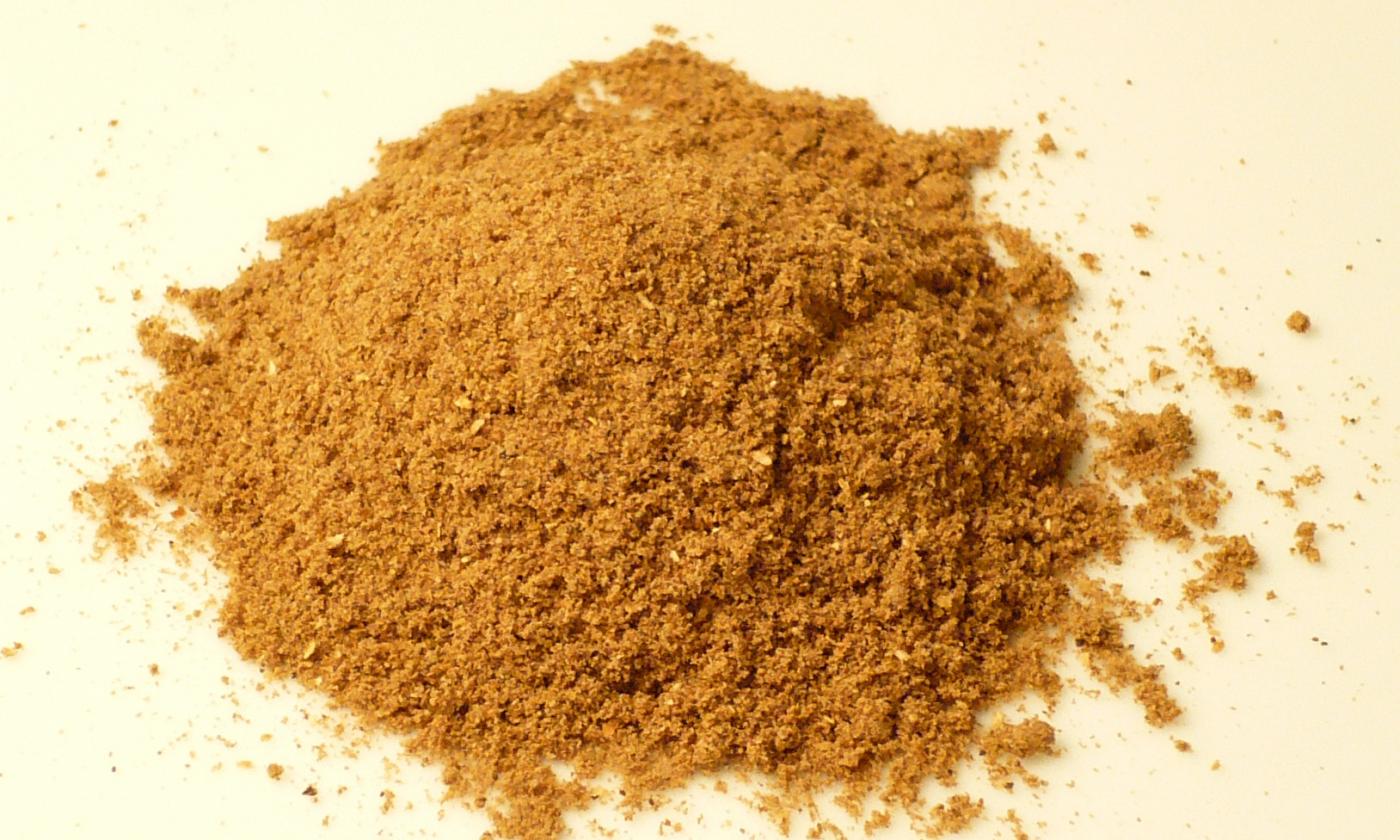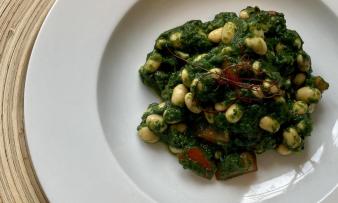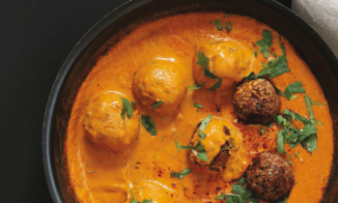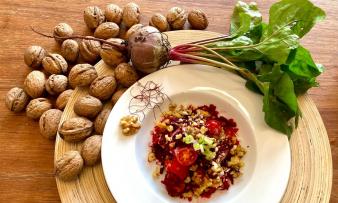Table of contents
Garam Masala is an Indian spice mixture ( organic) made of often roasted and ground spices that is often used to prepare curries. If you make the mixture yourself, you can buy it in raw food quality ( raw) grind.
Using Garam Masala in the kitchen:
What is Garam Masala? The traditional spice mixture from Indian cuisine consists of various individual spices. There is no standard Garam Masala composition. The recipe varies depending on the region and Indian family recipe. The mixture usually contains black cardamom, cumin,black pepper, cinnamon and cloves. Chili, cayenne pepper, garlic ( garlic granules), coriander seeds, nutmeg, star anise, mustard seeds, green cardamom and bay leaves are often added to the mixture. Fennel seeds are also occasionally added to reduce any spiciness.
What does garam masala taste like? The taste of the tobacco-brown mixture depends on the ingredients it contains, usually a combination of spicy and delicately sweet. Is garam masala spicy? Pepper and chili produce the mild to intense spiciness, while cardamom, nutmeg and cinnamon give the mixture a mild sweetness. The spices in garam masala are often roasted before grinding, i.e. no longer raw. This is intended to develop the aroma of the essential oils. However, this does not apply to all spices: caraway, cloves and juniper berries develop their aroma better with heat, but nutmeg, pepper and paprika are sensitive to heat. 7
What is Garam Masala for? The spice mixture is ideal for preparing Indian dishes such as vegetable curries (e.g. with chickpeas, potatoes, cauliflower, etc.) and vegetable dals (e.g. dal made from lentils, sweet potatoes and spinach). The basic sauce Makhani sauce (vegan), which is an important component of many Indian dishes, is prepared with Garam Masala. In pumpkin or tomato soups, in soup creations such as chestnut and carrot bisque or in the rice dish Pilaf, the spice mixture conjures up a fine, oriental note. It is best to add the spice mixture at the end of the cooking process so that the aroma can develop optimally. The spice can also enrich salads, couscous tabboulehs, dumplings (e.g. Momos) and vegan patties.
Garam Masala is not only used in savoury dishes. The mixture also gives sweet dishes and desserts that certain something. Chocolate cakes, puddings and creams or festive gingerbread, spice cakes, "crumbles" (fruits baked with crumbles such as apples, rhubarb, plums) or "pumpkin pies" (typical American pumpkin pie) can all be made with the spice. You can also use it to spice up breakfast, such as muesli, porridge or banana bread.
You can also use the Indian spice mixture to flavor tea. For this, you mainly use black tea by adding a pinch of the spice powder to the tea per cup, letting it steep and, if necessary, refining it with vegan milk or cream and sweetening it with a little agave syrup.
Recipe for tea with Garam Masala - Vegan Masala Chai:
Ingredients (for approx. 4 cups): 1 stick of cinnamon, 4 cloves, 4 green cardamom pods (without shells), approx. 2 cm of fresh ginger, 4 black peppercorns, 2 prongs of star anise, 1/3 teaspoon of fennel seeds, 720 ml of water, 3 black tea bags, 120 ml of plant milk ( oat milk, rice milk, almond milk), 2 teaspoons of brown sugar (or agave syrup), 1 pinch of salt.
Preparation : Bring water to the boil in a pot with the spices and simmer for a few minutes. Reduce heat, add black tea and let steep for 10 minutes. Add milk, salt, sweetener and bring the mixture to the boil again. Pour the vegan masala chai through a sieve into four cups and serve hot. Optionally, you can decorate each cup with foamed plant milk. You can vary the amount of sweetener as needed.
Recipe for vegan pumpkin soup with garam masala:
Ingredients (for 2 people): 1 pumpkin (e.g. Hokkaido pumpkin), 600 ml vegetable stock, 1 small piece of ginger, 1-2 tbsp garam masala (organic), some salt, pepper, chili powder and nutmeg, oat cream as desired.
Preparation: Peel the pumpkin if necessary, halve it, remove the seeds and dice the rest. Cut the ginger into small pieces. Put the pumpkin and ginger in a large pot with the vegetable stock and bring to the boil. Continue cooking on a low heat until the pumpkin is cooked. Remove the pot from the heat and puree the contents with a hand blender. For a creamy consistency, stir in oat cream as desired. Season with 1 tbsp garam masala and add more seasoning if desired. Season the garam masala pumpkin soup (vegan) with salt, pepper, chili and nutmeg, mix well and serve.
Vegan recipes with garam masala can be found under the note: " Recipes that have the most of this ingredient ".
| Not only vegans or vegetarians should read this: Vegans often eat unhealthily. Avoidable nutritional errors. |
Shopping - where to buy Garam Masala?
Well-stocked branches of many supermarkets (e.g. Coop, Migros, Denner, Volg, Spar, Billa, Aldi, Lidl, Rewe, Edeka, Hofer) stock Garam Masala - with different compositions. In organic supermarkets (e.g. Alnatura, Denn's Biomarkt) and health food stores, the spice mix is also available in organic quality (bio). You can also find variants of Garam Masala in many Asian shops and online shops. The spice mix is usually found in powder form, but it can also be bought as whole spices or as a paste. In stores you can find spice mixes called Masala or Masala spice mix, but these are not necessarily Garam Masala.
Please read the ingredients, as salt ( sea salt) is often included. Occasionally you will also find ingredients such as allspice, oregano or a few roasted spices in the mixture.
There is no Garam Masala alternative in this sense; the individual ingredients are considered as a replacement for this spice mixture.
Make your own Garam Masala:
With this Garam Masala recipe you get a raw spice mixture with a filling volume of approx. 100 ml (12-15 portions).
Ingredients: 1 tbsp cumin seeds, ½-1 tsp coriander seeds, 1 tspblack pepper, 1 ½ tsp black cardamom pods (remove seeds before grinding), 1 tsp cinnamon, 5-6 cloves, ½ tsp nutmeg.
Preparation: Grind the ingredients to the desired fineness using a mortar or a mill. Mix all the ground ingredients well and then store in an airtight container in a cool, dark place. If you roast the whole spices before grinding, you will get a more intense aroma, but the spice mixture will no longer be raw.
Storage:
Garam Masala, like other spices, should be stored in a dry, cool and well-sealed place to keep the aroma as intense as possible for as long as possible - however, constant loss is unavoidable over a long period of time. As long as the spice mixture does not come into direct contact with liquid and thus begin to mold, it will last for years. It can be stored the longest in unprocessed form, i.e. raw and not roasted.
Garam Masala: Ingredients - Nutritional values - Calories:
Here we realistically show you the ingredients of spices and herbs per 1 g (instead of per 100 g as usual).
There are 3.48 kcal in 1 g of Garam Masala. 0.56 g of carbohydrates, 0.16 g of fat and 0.11 g of protein are also contained in 1 g of the spice mixture. 1
The spice is rich in manganese. The content of 0.15 mg/1g (7.6% of the daily requirement) is comparable to that of turmeric powder (0.2 mg/1g) and cinnamon powder (0.17 mg/1g). Ground cloves contain a particularly high amount of manganese at 0.6 mg/1g. 1
Garam Masala contains 0.46 mg of iron per 1 g (3.28% of the daily requirement). Similar amounts can be found in turmeric powder (0.55 mg/1g) andvanilla powder (0.38 mg/1g). Dried thyme contains almost three times as much iron at 1.24 mg/1g. 1
The calcium content is 11.48 mg per 1 g (1.44% of the daily requirement). Fennel seeds (11.96 mg/1g) and vanilla powder (12.28 mg/1g) contain a similar amount. With 22.4 mg/1g, dried basil is extremely rich in calcium. 1
The complete ingredients of Garam Masala, the coverage of the daily requirement and comparison values with other ingredients can be found in our nutrient tables. In the article Nutrients explained you will get a detailed insight into the topic.
Health aspects - effects:
Is garam masala healthy? The exact effect of garam masala depends, of course, on the recipe of the spice mixture. However, studies have shown that many of the spices typically contained in it have antioxidant properties. A 2016 study also showed activity against the pathogens Staphylococcus aureus and Bacillus cereus, which was mainly attributed to the presence of cinnamon. 2 Cinnamon not only has antioxidant and antimicrobial effects, but also has anti-inflammatory, antidiabetic and lipid-lowering effects. It is also said to help with neurological disorders such as Parkinson's and Alzheimer's. 3
Another study found that consumption of garam masala resulted in desirable changes in the levels of enzymes of the detoxification system. These results suggest the blend's possible chemopreventive effect and its potential as a natural cancer preventive agent. 4 Additionally, the blend may promote heart health. 5
For further potentially health-promoting effects, check out the individual spices in the spice blend, such asblack pepper, cumin, chili, cloves, cardamom and cinnamon.
Dangers - Intolerances - Side effects:
If you are allergic to one of the common garam masala ingredients, you should carefully read what is contained in the commercially available mixtures and avoid them if necessary.
Side effects of excessive consumption such as skin rash, itching, burning sensation in the mouth, flatulence, diarrhea and vomiting are mentioned in some sources but are not scientifically proven.
Folk medicine - natural medicine:
In Ayurvedic medicine, the spice Garam Masala is said to have a warming, heating effect due to its composition, which is said to raise the body temperature and stimulate metabolism and digestion. This is said to make it possible to prevent the accumulation of toxins.
Occurrence - Origin:
It is assumed that the spice mixture Garam Masala originated in northern India, where it was sprinkled into dishes as a warming addition, especially in cold winters. However, the popularity of the Garam Masala mixture spread quickly and is now an integral part of the cuisine of all of India. 6 Nowadays, the spice mixture is also frequently used in Pakistan, Sri Lanka and Bangladesh.
Possibility of confusion:
Garam Masala and curry are not the same thing. In Europe, spice mixtures containing turmeric, which gives the dish its yellow color, are called curry. In India, a curry is not a spice mixture, but a prepared dish. Does masala mean spice mixture? The Indian term for spice mixture is "masala". Garam masala is a specific, "hot" spice mixture ("garam" means hot) which, unlike curry powder, does not contain turmeric powder, but is often added to curry dishes to refine the flavor.
There is also confusion between Garam Masala and Tikka Masala (usually Chicken Tikka Masala). Tikka Masala is a dish from Indian-British fusion cuisine. Chicken Tikka is an Indian dish with grilled chicken. In Great Britain, it is served in masala sauce, i.e. sauce refined with spice mixtures (masala) - often with garam masala - which then results in the dish Chicken Tikka Masala. Tikka Masala can also be prepared vegetarian and vegan.
General information:
There is no such thing as just one Garam Masala spice mix. The spice mix can consist of over 30 individual spices in different quantities. 6
Alternative names:
Garam Masala is also called this in German. Incorrect spellings (e.g. Masala Garam, Garam Marsala, Garam Massala, Gram Masala, Garam Massla, Garan Masala, Garam Masalla, Gara Masala, Garamasala, Garam Masal, Gran Masala, Graham Masala) creep in.
In English, the spice blend Garam Masala is called Indian spice blend Garam masala.
Literature - Sources:
Bibliography - 7 Sources (Link to the evidence)
| 1. | USDA United States Department of Agriculture. |
| 2. | Basu T, Bhattacharyya S, Maitra S, Rai C. Evaluation of Antioxidant and Antimicrobial Activities of Garam Masala, an Indian Spice Blend, and Its’ Components In Vitro. Der Pharmacia Lettre. 2016;8(20):110–116. |
| 3. | Rao PV, Gan SH. Cinnamon: a multifaceted medicinal plant. Evid Based Complement Alternat Med. 2014;2014:642942. |
| 4. | Singh A, Rao AR. Evaluation of the modulatory influence of food additive-garam masala on hepatic detoxication system. Indian J Exp Biol. 1992;30(12):1142–5. |
| 5. | Dattatray S, Kamini B, Manjula, Mohanlal J. Garam masala (Mixture of spices) for cardiac health: An overview. Journal of Indian System of Medicine. 2016;4(4):211-22. |
| 6. | Spiceography.com Garam Masala: India’s Most Complex & Healthful Spice Blend. |
| 7. | Verbraucherzentrale-bayern.de Soll man Kräuter und Gewürze mitkochen? 2018. |











Comments